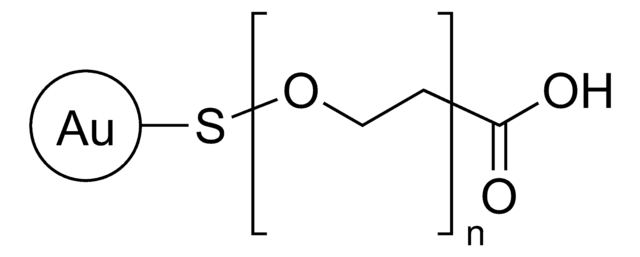765341
Gold nanoparticles
20 nm diameter, amine functionalized, PEG 5000 coated, OD 50, dispersion in H2O
Sinonimo/i:
Gold nanoparticles NH2 functionalized, Au NP NH2, Gold Colloid
About This Item
Prodotti consigliati
Materiali
PEG 5000
Livello qualitativo
Forma fisica
dispersion in H2O
nanoparticles
Confezionamento
poly bottle of 1 mL
OD
50
Diametro
20 nm
pH
6.0-8.0 (25 °C)
Solubilità
water: miscible
Densità
1.00 g/cm3
λmax
520 nm
Gruppo funzionale
amine
Temperatura di conservazione
2-8°C
Cerchi prodotti simili? Visita Guida al confronto tra prodotti
Descrizione generale
Applicazioni
- Since they adhere to cell membranes, AuNPs are used in cellular and intracellular targeting in targeted drug delivery applications and may also be used in biodistribution studies
- AuNPs may also be used in photothermal therapy and radiotherapy.
- Proposed applications of gold nanoparticles are as:drug delivery agents for cancer therapy, coatings, plastics, nanowire, nanofiber, textiles, catalyst applications.
- They may also be used in carrying siRNA which acts against human prostate carcinoma cells by inhibiting a specific cancer gene.
Caratteristiche e vantaggi
- The negatively charged siRNA-PEG complex, attached to positively charged GNPs, is easily cleavable in reductive cytosolic environment thus enabling the release of siRNA into cytosol.
- The PEG coating decreases the cytotoxicity and increases effciciency of GNPs. PEG increases the stability of the nanoparticles and prevents agglomeration.
Codice della classe di stoccaggio
12 - Non Combustible Liquids
Classe di pericolosità dell'acqua (WGK)
WGK 2
Punto d’infiammabilità (°F)
Not applicable
Punto d’infiammabilità (°C)
Not applicable
Scegli una delle versioni più recenti:
Certificati d'analisi (COA)
Non trovi la versione di tuo interesse?
Se hai bisogno di una versione specifica, puoi cercare il certificato tramite il numero di lotto.
Possiedi già questo prodotto?
I documenti relativi ai prodotti acquistati recentemente sono disponibili nell’Archivio dei documenti.
I clienti hanno visto anche
Articoli
The recent emergence of a number of highly functional nanomaterials has enabled new approaches to the understanding, diagnosis, and treatment of cancer.
Biomaterials science involves the design and fabrication of smart materials for studying, directing, or mimicking biology. For successful integration of biomaterials in biological research, a meaningful understanding of biological systems is required.
Il team dei nostri ricercatori vanta grande esperienza in tutte le aree della ricerca quali Life Science, scienza dei materiali, sintesi chimica, cromatografia, discipline analitiche, ecc..
Contatta l'Assistenza Tecnica.





